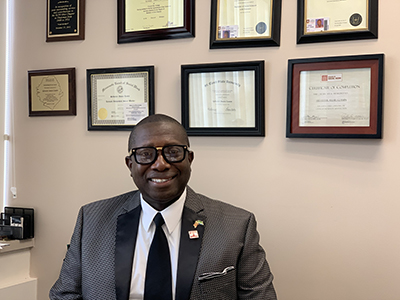Saint Mary's Newsroom / Campus Notes
Winona Campus Newsletter
Full circle: MSW professor lectures, gives back in home country of Sierra Leone
Looking at the group photo, the members’ smiles are almost as bright as the orange vests they wear.
Those gathered in the Central Business District of Freetown, Sierra Leone, are all part of a service organization that has been handing out meals every Sunday to the area’s homeless for two years.
“I provided all of those from the purchases I made,” said Sylvester Amara Lamin, Ph.D., looking at the photo.
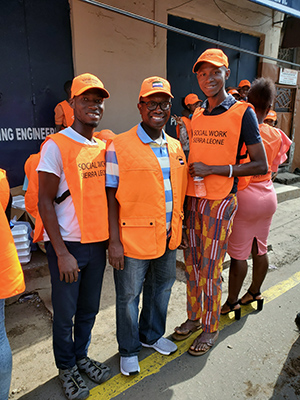
Sylvester Amara Lamin (middle) poses with two workers from Social Workers Sierra Leone. Lamin spent a Sunday handing out food to the homeless and mentally ill who live on the streets of Freetown, Sierra Leone, on a recent trip back to his native country.
Lamin serves as a core associate professor for the newly started Master of Social Work (MSW) online program at Saint Mary’s University of Minnesota, which will host its first MSW Field Fair on Wednesday, March 25, from 3 to 5 p.m. at the University Center on the Twin Cities Campus. The program, which welcomed its first students in fall 2019, had the largest initial enrollment of any online program in the history of Saint Mary’s University.
“With the expertise of our professors, we focus on more of the clinical component, which is unique, especially when it comes to an online program,” said Dr. Lamin, who joined the Saint Mary’s community in January 2019.
Dr. Lamin makes an annual pilgrimage to his home country every year during winter break. On his most recent trip, he was invited to give a lecture at his undergraduate alma mater, Fourah Bay College (FBC), and take care part in the service group’s ministry on Jan. 5.
Many volunteers come every Sunday. Thanks to Dr. Lamin buying them at the hunting season’s conclusion, the regulars have their own personal vests embroidered with the group’s name, Social Workers Sierra Leone. Dr. Lamin also sends monetary donations to support the group’s mission. In addition, the group was able to hand out small toiletries such as toothpaste and toothbrushes, after Dr. Lamin’s wife gathered up the supplies to disperse.
The organization was founded in 2018 by Hassan Koroma after he witnessed a food vendor refusing to sell food to a homeless woman. Koroma gave the woman the food he was eating.
“That was what motivated him to start feeding the homeless. He knew that her situation was not unique to her alone in the Central Business District of Freetown,” Dr. Lamin said.
Through donations, the group is able to hire a cook who makes meals — usually consisting of rice with various sauces — and then hand them out to people on the streets.
The organization also provides meals for those dealing with mental health issues who have nowhere to go given that the city’s own psychiatric center — one of the oldest in Africa, having been established in 1820 — is over capacity.
“Many of them are on the streets because not all of them can go to the hospital,” Dr. Lamin said.
This is the reality of Sierra Leone, a West African country that has approximately 7.5 million citizens, with over a million of whom live in the Freetown area. As such, there is a significant resource issue, given that there is a large imbalance of social services in Freetown compared to the rest of the country — in spite of the fact that a majority of people work for the country’s government in various capacities, Dr. Lamin said.
“There is some form of decentralization going on, but not at the speed you really want,” he said.
Establishing a foundation
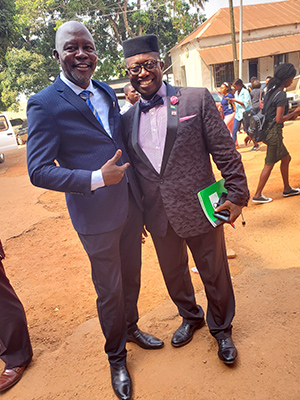
Sylvester Amara Lamin with Patrick Walker, head of the Department of Sociology and Social Work at Fourah Bay College, on the college campus in Freetown, Sierra Leone.
Patrick Walker, head of the Department of Sociology and Social Work at FBC, invited Dr. Lamin to give the Jan. 7 lecture. The talk provided an overview of the history and current trends of social work practices and education in the U.S., as well as lessons that could be learned and models emulated by Sierra Leone.
As Dr. Lamin explained in his lecture, the concept of modern-day social work largely came from the criticism of an American educator named Abraham Flexner, who in 1915 stated in an essay titled, “Is Social Work a Profession?” that social workers needed professional qualities and classifications.
Flexner’s comments, in part, led to the Council on Social Work Education (CSWE) being founded in 1952, for accrediting social work education programs in the U.S. Three years later, the National Association of Social Workers began as a professional resource. In 1979, the American Association of State Social Workers (later called the Association of Social Work Boards) started providing accreditation exams. All of these institutions have created structure within the profession, Dr. Lamin said.
It is the hope of those at FBC, which is a part of the University of Sierra Leone system, to create a master’s level social work program similar to the ones that have been established in the U.S.
Based on the crowded, large room full of teachers and faculty where he spoke, the interest is certainly there — but the structure and the resources needed are not.
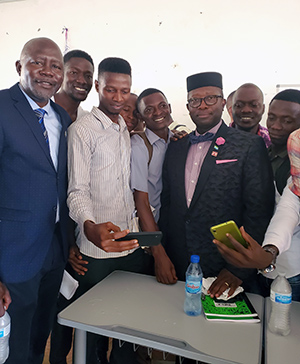
On the day of his lecture at Fourah Bay College, Sylvester Amara Lamin took time for photos with students from the college. Patrick Walker is on the far left.
As opposed to the specialized, clinical focus of the MSW program at Saint Mary’s, the greatest need in Sierra Leone, Dr. Lamin said, is to have a master’s program with a generalist focus, allowing graduates to work anywhere they are needed.
Perhaps the greatest issue is what Dr. Lamin referred to as title protection, meaning that someone in a certain field, such as social work, has the proper credentials to back up the claim of their title, harkening back to Flexner’s sentiments from 105 years ago.
In 2016, a group that included Koroma took the initial steps to establish a Sierra Leone chapter of the International Federation of Social Workers, but that effort is still very much in its infancy.
“You can’t just call yourself a social worker. You have to have the requisite educational training backed by your licensure,” Dr. Lamin said. “The professional title needs protection.”
Featured image: Members of Social Workers Sierra Leone take a group photo clad in their bright orange gifts, which were donated from Sylvester Amara Lamin, associate professor of the MSW program.
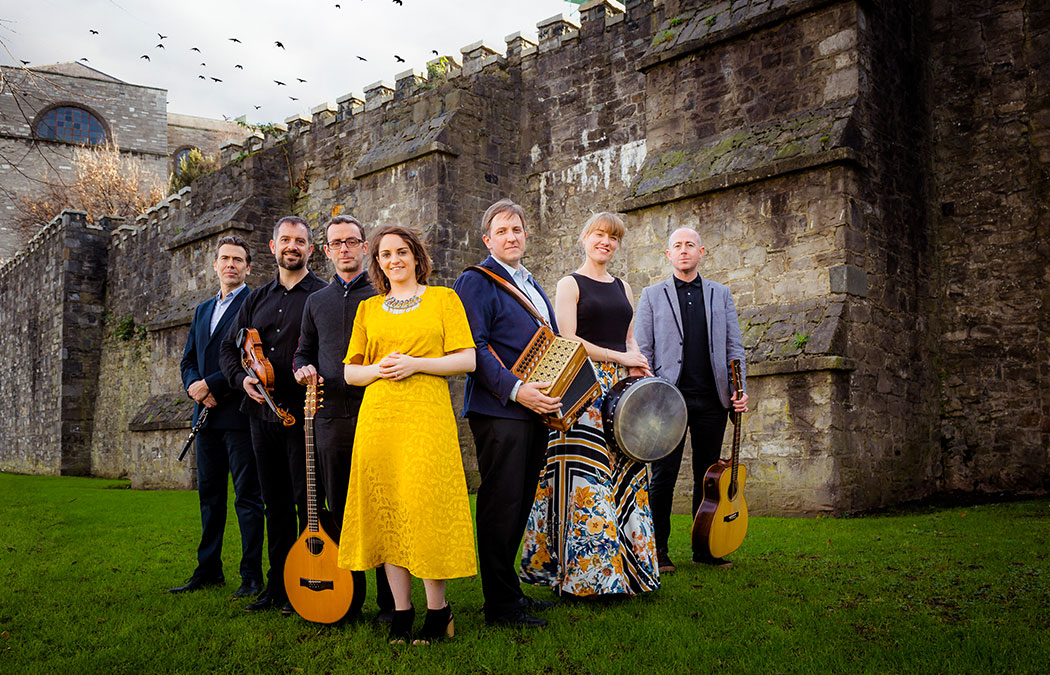
Page Series to present internationally acclaimed Irish ensemble Danú Feb. 27
WINONA, Minn. — The Page Series at Saint Mary’s University of Minnesota will bring renowned Irish music ensemble Danú to Winona for one night only. The band will perform a 7:30 p.m. concert at the Page Theatre on Thursday, Feb. 27.
Hailing from historic Counties Waterford, Cork, Donegal, and Dublin, Danú is one of the leading traditional Irish ensembles of today and has been lauded for their “vibrant mix of virtuosity, energy, and empathy” by The Washington Post. Their standing room only concerts throughout Ireland feature high-energy performances and a glorious mix of ancient Irish music and new repertoire.
Danú’s virtuosi players on flute, tin whistle, fiddle, button accordion, bouzouki, and vocals (Irish and English) have performed around the globe and recorded seven critically acclaimed albums. Their live DVD, “One Night Stand,” was filmed at Vicar St. Dublin. Winners of numerous awards from the BBC and Irish Music Magazine, Danú has toured throughout Europe, the Middle East, and North America with stops at The Hollywood Bowl in Los Angeles, Symphony Space in New York City, and major concert engagements in the United Kingdom, India, Israel, and across Europe. Danú takes its audiences on a musical journey to their native Ireland, offering a moving and memorable concert experience. Danú’s popular recordings are available on the Shanachie label, and live performances are often broadcast on NPR, CBC, and BBC.
Prior to the performance, Danú will also offer a free Page in History talk at the Winona County History Center Thursday, Feb. 27, at 3 p.m. Band members will share about their 25-year history of performing around the globe, introduce themselves and their instruments, and perform a preview of their Page Series concert. This program is open to all; registration is not required to attend the talk.
Tickets for the performance are $27 for adults, $24 for seniors and students, and $18 for youth ages 17 and younger. Tickets can be purchased online at pagetheatre.org, or by calling the Saint Mary’s Performance Center box office at 507-457-1715 (noon to 6 p.m., weekdays).
About the Page Series
Now in its 33rd season, the Page Series connects professional performing artists from around the globe with thousands of Winonans each year. With events at the Joseph Page Theatre on the Winona Campus of Saint Mary’s University of Minnesota, as well as at locations across the Winona community, the Page Series offers dance, music, and theatre performances, workshops, classes, and more that inspire, uplift, educate, and invite community members to discover the relevance of the arts in their daily lives.
This activity is made possible by the voters of Minnesota through a Minnesota State Arts Board Operating Support Grant, thanks to a legislative appropriation from the arts and cultural heritage fund.
This activity is made possible by the voters of Minnesota by a grant from the Southeastern Minnesota Arts Council, thanks to a legislative appropriation from the arts and cultural heritage fund.
Page Series community programs are made possible, in part, through grants from the Xcel Energy Foundation.
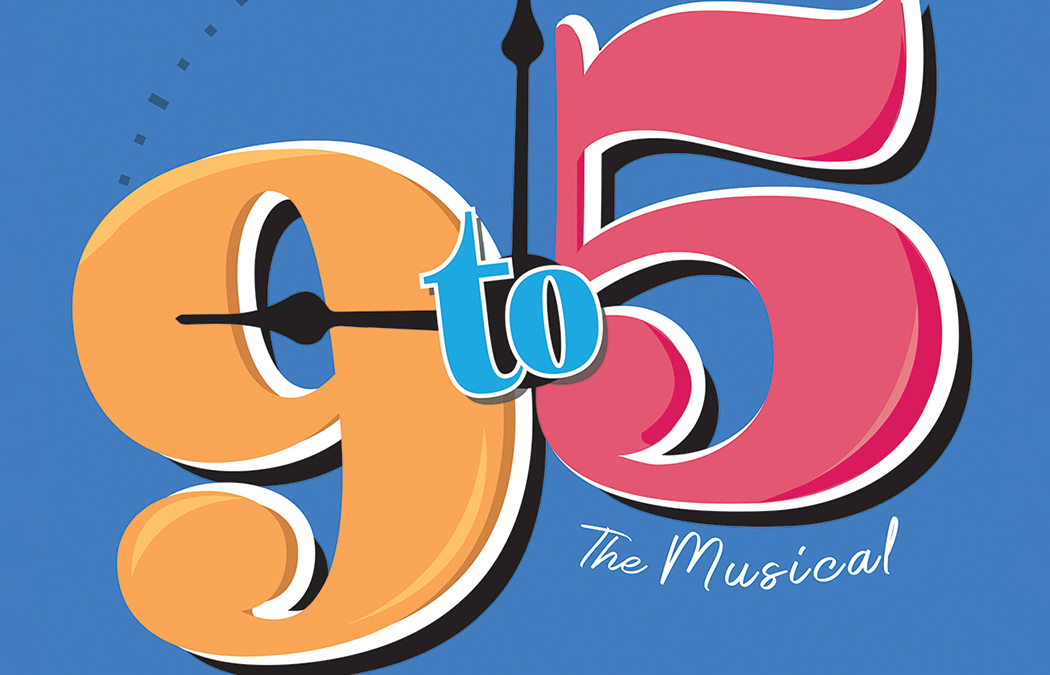
Saint Mary’s students to stage ‘9 to 5: The Musical’ Feb. 20-23
WINONA, Minn. — Never underestimate the power of friendship or the strength of a woman — much less three! Saint Mary’s Department of Theatre and Dance will stage a familiar and funny favorite, “9 to 5: The Musical,” Thursday through Sunday, Feb. 20-23 in Page Theatre.
Based on the 1980 hit movie and set in the late 1970s, this hilarious story of revenge in the Rolodex era is outrageous, thought-provoking, and even a little romantic.
Pushed to the boiling point, three female coworkers concoct a plan to get even with the sexist, egotistical, lying, hypocritical bigot they call their boss. In a hilarious turn of events, Violet, Judy, and Doralee live out their wildest fantasy — giving their boss the boot! While their boss remains “otherwise engaged,” the women give their workplace a dream makeover, taking control of the company that had always kept them down. Hey, a girl can scheme, can’t she?
The musical is based on a book by Patricia Resnick, with music and lyrics by Dolly Parton. Saint Mary’s students are under the direction of Judy Myers.
Showtimes are 7:30 p.m. Thursday through Saturday, Feb. 20-22, and 3 p.m. Sunday, Feb. 23. Tickets are $10 for adults, $5 for students and seniors and are available at www.pagetheatre.org or by calling the Performance Center box office at 507-457-1715 from noon to 6 p.m. weekdays.

A quick study: Learning Design and Technology graduate earns statewide recognition for work inside and outside classroom
When it comes to his work for Alexandria Public Schools, Lukas Gotto M’17 has a phrase that sums up his teaching philosophy: Cool is exciting. Exciting is engaging. Engaging leads to learning.
“That slipped out of my mouth one day when I was explaining it to somebody, and I’m like, ‘Oh, that sounded better than I intended,’” added Gotto, with his typical self-deprecating humor.
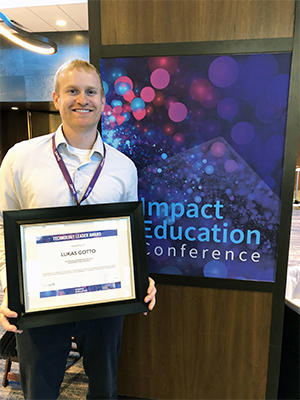
Lukas Gotto M’17 stands with the 2019 Technology Leader of the Year award at the Impact Education Conference in December in Minneapolis. Above, Gotto stands with Chad Coauette, executive director/CEO of Sourcewell Technology, after being presented with the award.
In December, Gotto was named the 2019 Technology Leader of the Year (watch a video made for the award ceremony) at the statewide Impact Education Conference, sponsored by Sourcewell Technology, two years after he earned his M.Ed. in Learning Design and Technology (LDT) from Saint Mary’s University of Minnesota and became Alexandria Public Schools’ first instructional design technologist.
What was one of his immediate thoughts when he heard the news?
“What? Really? Who messed up?,” Gotto said with a laugh. “I was just shocked and very humbled and honored.”
What cannot be downplayed, though, is the impact on the school district’s students, faculty, and staff both within the classroom space and outside of it.
“His disposition, zeal, and accomplishments are illustrations of one of the goals of the LDT program, which is to help students develop skills, mindsets, and capacities so they can be change agents in their schools, organizations, and communities,” said Nancy Van Erp, Ph.D., the LDT program director.
Setting a new course
Gotto first arrived in Alexandria in 2014 as an eighth-grade social studies teacher, a position he served for three years. In 2016, Gotto decided he wanted to pursue a master’s degree but had to find one that was completely online given his coaching commitments with football, baseball, and boys’ and girls’ basketball teams. He came across information about the LDT program, which piqued his interest, given that it merged his passion for social studies with educational technology.
Looking back at his time in the program, Gotto was impressed with the attention that was being paid to design thinking. Although the concept is now found in educational settings everywhere, that was not the case when Van Erp first presented it to Gotto and his classmates, he said.

Lukas Gotto M’17 works with staff members of Alexandria Public Schools during a professional development session. Gotto has created a “Technology Champions” program within the district in which he teaches faculty and staff members throughout the school year about the latest technology so they can, in turn, introduce it to their students.
“It was fun because I was sending articles and books to our assistant superintendent and people several years ago before they were talking about it and now it’s such a big thing,” Gotto said.
As he was finishing up his degree at Saint Mary’s, talk surfaced of creating an instructional technologist within the school district, based out of Discovery Middle School. Eventually he was offered the position, a decision that was tough given his love of teaching in a traditional classroom setting.
“I do miss it, but there’s something about this job that’s always new and different,” Gotto said. “I really enjoy that aspect of it.”
For his capstone project, Gotto created a professional development model for what would become known as “Technology Champions.” Given that he is the only person of his position within the entire district, that model would turn into a program in which faculty spend four half-days being taught by Gotto about the latest educational technology devices using a motto he picked up in the LDT program: I do. We do. You do.
He uses the same practice when working with students by getting in front of the class for the first class period, then standing next to the teachers as they provide instruction.
“So that way, if they have questions, I’m still right there,” Gotto explained. “And then by the last hour of the day, I’m typically out of the classroom. They’ve done it by themselves.”
With the assistance of the local Alexandria Education Foundation, Gotto has been able to secure more than $10,000 in grants to introduce students to a variety of educational-based technology including drones, augmented reality headsets, and little robotic balls known as Spheros, which students work with through mathematical, scientific, and coding platforms to program their movement (read an article that Gotto wrote about them for EdTechTeam).
The importance of unplugging

Lukas Gotto M’17 works with second grader Archer Swaggert with a large saw during the recent construction of a bridge/boardwalk behind Discovery Middle School in Alexandria this past summer.
Gotto grew up as the oldest of three brothers in Windom, Minn., a 90-minute drive east of Sioux Falls, S.D. Interestingly enough, his parents would set hard limits on video games or other types of technology for their children, which often involved competitions of “Guitar Hero” on PlayStation 2.
“We grew up on an acreage with horses, so there was always something that needed to be done outside,” Gotto said. “That was their mindset, ‘You don’t need that. You can just go outside.’”
As a result, Gotto held a fascination for technology, while maintaining a love to be outside and work with his hands.
Gotto’s love for the outdoors led to an idea to build a bridge/boardwalk structure that would extend a trail beyond some marshy lands in the back of the middle school. He had worked on previous projects for other school districts during the summers, so it was only fitting that he would help construct one for his own school, which sits on more than 100 acres of land.
Gotto met with members of the community who agreed to donate either time, money, expertise, or equipment to make the project a reality this past summer. In total, six different businesses stepped forward, including a bridge company that donated four 30-foot steel beams.
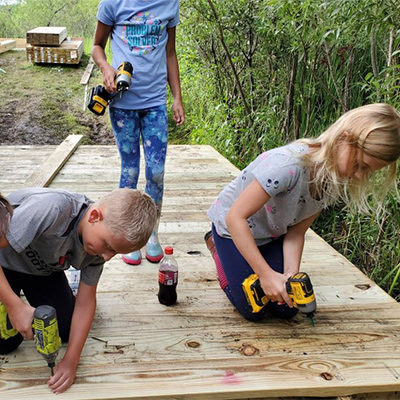
Fourth grader Nate Fuglestad, left, and third grader Avery Olson help construct part of the bridge/boardwalk behind Discovery Middle School. They were just two of the students Lukas Gotto M’17 enlisted to help with the project.
“We installed those without the kids because that’s some heavy metal going around, but then they did the rest of it,” Gotto said of the numerous students who worked side-by-side with their teacher’s assistance.
“The kids absolutely rocked it,” Gotto said. “It was fun to see them use a saw or a screw gun for the first time.”
Given how busy his life is — he and his wife, Alicia, have a one-year-old daughter — Gotto appreciated how seamlessly his degree from Saint Mary’s fit into this life. He has encouraged fellow educators who are thinking about pursuing a master’s degree to look into the program.
“I really enjoyed not having to meet in person. That was really high on my list,” he said. “And so if that’s really high on your list — whether you’re doing it during the Vikings game on Sunday, or you’re trying to get it all done on Thursday so you don’t have to miss the Vikings game — it’s nice to have that option.”
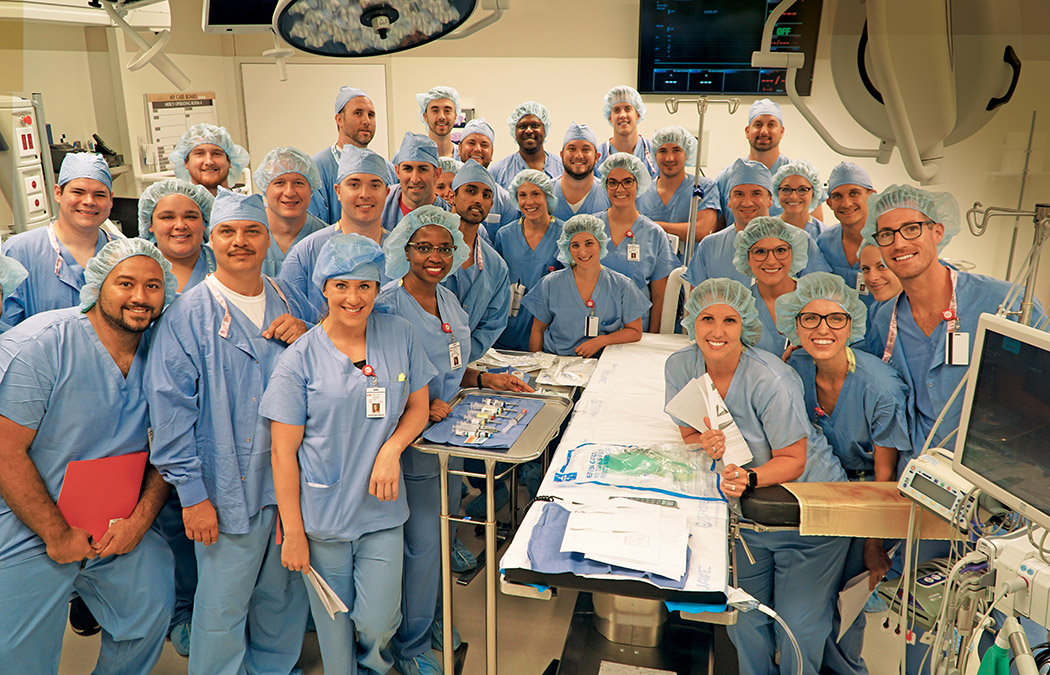
Saint Mary’s graduates rank high for earning potential
The Minneapolis Saint Paul Business Journal reported that, per federal data from the U.S. Department of Education, Minnesota’s highest first-year earners are certified registered nurse anesthetists who earned their master’s degrees from Saint Mary’s University.
Leah Gordon, director of the Saint Mary’s M.S. in Nurse Anesthesia Program, said it’s a specialization that can bill independently for services, which contributes to its high earnings. She also said Saint Mary’s graduates are in demand right now.
Saint Mary’s B.S. in Nursing is also at the top of the list, and many other Saint Mary’s programs rank high in comparable first-year earning lists. Read more about these rankings.
United Nations’ Sustainable Development Goals fall behind initial hopes, lacks needed funding
In 2000, United Nations member states adopted eight Millennium Development Goals (MDGs), which featured a number of ambitious global initiatives, such as eradicating extreme poverty and hunger, and achieving universal primary education in all countries around the world.
As these goals were extremely aspirational, most were far from met by the target date. However, by 2015 significant progress was made in a few areas, such as increased official development assistance (foreign aid), reduced trade barriers for developing country exports, and new debt-reduction strategies for some of the heaviest indebted countries. By the target date of the MDGs, the most notable outcome was the number of people living in extreme poverty around the world had been reduced by 50% since 1990.
To keep the sustainable development agenda moving forward, at the end of 2015, the United Nations member states adopted 17 new Sustainable Development Goals (SDGs) to be met by 2030.
“The new SDGs carry over some of the same aspirational initiatives from the MDGs, such as eliminating poverty and achieving zero hunger, but have also added some new goals, which may arguably be more attainable in the near term, such as affordable and clean energy; climate action; and reduced inequality,” says Matt Bluem, Ph.D., assistant dean of graduate programs and MBA program director at Saint Mary’s University of Minnesota’s School of Business and Technology.
Since the adoption of the SDGs in 2015, some progress has been on two of the SDGs: eliminating preventable deaths among newborns and children under the age of 5, and getting children into primary schools. These are both important initiatives and progress should be celebrated, Bluem says.
Unfortunately, progress on the other 15 goals has not kept pace. With just 10 years until the target date for meeting all 17 SDGs, it is becoming increasingly clear that most of these goals will not be met.
“Initiatives such as eliminating extreme poverty, ending hunger, and protecting the climate are quite far from being achieved — and in some cases, are going in the wrong direction,” Bluem says.
According to the UN, the biggest challenge in meeting the SDGs is funding. An additional $2-3 trillion is needed to help meet funding requirements. A recent report by the Brookings Institution states that sub-Saharan Africa alone would need hundreds of billions of dollars in additional financial support every year in order to meet the SDGs by the target date of 2030, Bluem says.
U.N. Secretary-General António Guterres has argued that public investment by governments is not enough, insisting that private industry is going to need to get involved. To meet the aggressive SDGs, the private and public sectors will need to work together to bring about the investment and policy change.
In order to encourage governments and the private sector to put the resources and effort necessary into meeting the SDGs, it is imperative to let world leaders know that goals such as the SDGs are important to the international citizenry, Bluem says.
“In a time that sees the United States withdraw from a vital initiative such as the Paris Climate Agreement, we all need to get involved to get efforts back on track,” Bluem says. “In the end, even if we are not able to fully meet the SDGs, perhaps their greatest value will be in bringing greater attention and focus to the imperative of sustainable development.”
Are you a journalist covering this topic and interested in an interview? That’s where we can help.
Matt Bluem, Ph.D., program director of M.A. in International Development, has taught business and marketing courses at Saint Mary’s University of Minnesota since 2008. Prior to Saint Mary’s, he worked in both the banking and the nonprofit sectors, most recently with a non-governmental organization (NGO) with operations in more than a dozen countries.
Bluem is an expert in political and economic development and is available to speak with media. To arrange an interview with him, simply click on his photo below to access his contact information.
Connect with:
Matt Bluem, Ph.D.
 Assistant Dean of Graduate Programs, MBA Director, School of Business and Technology
Assistant Dean of Graduate Programs, MBA Director, School of Business and Technology
Expertise: International Development, Political and Economic Development
View profile
Ants and plants, a mutually beneficial relationship
Ant-plant interactions are really common in nature, and while people might most often picture ants as carrying pieces of leaves cut from tropical plants, ant behavior in the Midwest is less appreciated.
Moni Berg-Binder, Ph.D., associate professor of biology at Saint Mary’s University, finds ant mediated seed dispersal, called myrmecochory, fascinating and says that the temperate deciduous forests here in North America have many examples of plants that engage with the native plant community.
“In myrmecochory, these plants, often spring ephemerals, which are early blooming spring plants, produce seeds with a nutritious structure that sticks off the seed called an elaiosome,” she said. “Typically what happens is the seeds fall to the ground which is called primary dispersal. The Ants forage and find the seeds on the ground and then pick up seeds and carry them to their nest. This is secondary dispersal. Then, once they get the seeds into their nests, those seeds are brought to places where developing larvae eat the elaiosome. But the seed is unharmed.”
From there, she said the seeds are then deposited in a chamber inside of their nests or they may take the seeds and put them in a refuse pile or a garbage dump just outside the nest. Ants, apparently, keep a very clean nest.
And oftentimes the ground soil around ant activity, is elevated in organic matter, nitrogen, phosphorous, possibly moisture — all really good things for plants and essentially the same thing as fertilizer. So the seed flourishes.
“It’s a beautiful example of mutualism,” she said. “The seed is taken and has effectively been planted inside this nest with nature’s fertilizer. The win from the ant perspective is that they received food.”
Dr. Berg-Binder and her students have focused their research on a plant called bloodroot. Local ants disperse the seeds of bloodroot.
Dr. Berg-Binder became interested in plant interactions while in graduate school when she became intrigued by the win-win scenario of mutualism. For her graduate work, she had been interested in conservation and how invasive species are introduced to a natural area where they did not typically belong. These invasive species can engage in mutualism with native species.
She said there is much more studying to be done on the relationship native ants have with both native plants and invasive plants.
Are ants helping the invasive species become more invasive? “They’re a great study system, and I find them really fascinating,” she said.
Are you looking to know more about invasive species or ant and plant interactions? Or, are you a journalist covering this topic and looking to book an interview? That’s where we can help.
To book an interview with Dr. Moni Berg-Binder, simply click on her photo below to access her contact information.
Connect with:
Moni Berg-Binder, Ph.D.
Associ ate Professor, Biology
ate Professor, Biology
Expertise: Invasive plant species and native plants; ecology and animal-plant interactions
View profile

A passion to serve: Saint Mary’s educator balances higher ed schedule with volunteer firefighting, emergency services
George Diaz M’10 claims that he has plenty of time for hobbies. They include taking a joy ride on his motorcycle and enjoying outdoor culinary arts such as grilling.
Given his daily lists of responsibilities, though, one could assume he might not get as much downtime as he would like. Not only does Diaz teach classes in the M.A. in Organizational Leadership program at Saint Mary’s University of Minnesota’s Twin Cities Campus, but he is also currently finishing up his Ed.D. in Leadership here.
He also serves as a firefighter in his adopted town of Hanover, Minn. He’s one of 26 volunteers who are on call at various parts of the week to watch after the people and buildings of Hanover and three neighboring communities in the far west of the Twin Cities metro area. Oh, and after completing advanced technical rescue training, he is also a member of the Wright County Special Response Unit based out of nearby Monticello — and he and his wife, Heather, have two children under the age of five.
Still, the man who had studied to be a police officer 19 years ago would not have it any other way.
When Diaz and his wife moved to Hanover in 2014, he quickly heard about the need to recruit more volunteer firefighters to the local operation. That same year, he began working at Saint Mary’s as an assistant professor. He could never imagine how much his academic and pedagogical pursuits would fall in line with his call to public service.
“When I left the law enforcement world, I always had some kind of urgency or want or need to go back to that field. My career path changed significantly, but I missed it,” Diaz said. “It was a decision that I didn’t know how much was going to change my life and my family’s life for the better.”
A higher cause
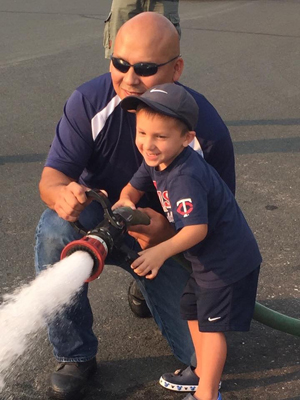
George Diaz M’10 shows his son, Sam, how to use the fire hose. Says Diaz: “When we’re out in the community, the kids will remember that we were at their schools and come talk to us.”
Perhaps there is no more defined correlation between Diaz’s two worlds as educator and civic protector than his involvement with the Minnesota Firefighters Foundation (MNFFF), a nonprofit organization that provides educational services for cancer prevention and raises funds for fire departments throughout the state.
As a member, Diaz has been part of a team to raise money for new hoods for rural fire departments with old and ineffective equipment. In 2019, as part of its “Hoods4Heroes” campaign, the foundation was able to purchase 500 hoods, valued at $100 each. As Diaz will tell you, the cancer-causing carcinogens largely enter the body through the neck and ear areas, making updated equipment a necessity.
Most fire departments run as both government agencies and nonprofits, Diaz said.
“The bridge between both the nonprofit and the government aspect is something you’ll see a lot in regular nonprofit and government contracts, where one relies upon the other, but that relationship alone has not been studied very well,” he said. “And there aren’t many degrees that look into it.”
To address dynamics such as these, Diaz helped develop the online M.A. in Public Administration program at Saint Mary’s, which started in 2018. The program had its first two graduates finish this past fall.
“When we teach people to be leaders, they’re going to be answering questions that have no answers. They just have to find the best next solution. That answer may not be the same tomorrow, because that answer is based on what we know right now and who we are with.”
—George Diaz
Diaz is proud of the partnership the MNFFF has formed with the University of Minnesota Masonic Cancer Center to conduct cancer research on firefighters in the Twin Cities metro area. As part of the study this spring, a group of firefighters will have their carcinogen levels monitored over extended periods of time to get more insight into the exposure to certain harmful cancer-causing chemicals they may encounter when putting out fires.
Based on the results, the foundation will work with the center to provide new recommendations to mitigate that exposure for firefighters.
When it comes to handling an actual fire, Diaz and his colleagues often resort to a tactic that he stresses to his students: Find your next best right answer.
“When we teach people to be leaders, they’re going to be answering questions that have no answers,” he said. “They just have to find the best next solution. That answer may not be the same tomorrow, because that answer is based on what we know right now and who we are with.”
The path of discovery
Diaz moved from the South Side of Chicago to Rochester, Minn., during his last year of junior high school.
After graduating from high school in 1999, his first inclination was to become a police officer. He pursed his associate’s degree in law enforcement at the local community college. During the last year of the program, though, his interest in a four-year degree began to grow. He enrolled at the University of Minnesota-Duluth on his way to a bachelor’s degree in criminology in 2005, before deciding to earn a history degree at The College of St. Scholastica in 2007 with the intention of applying to law school.
Diaz was accepted to the William Mitchell College of Law, but decided not to enroll. Around the same time in 2008, he was offered a position as a paralegal in the Hennepin County Attorney’s Office on its felony property unit before helping run a K-12 truancy prevention program.
During 2008, Diaz also began his relationship with the Twin Cities Campus at Saint Mary’s by starting to take classes for an M.A. in Counseling and Psychological Services.
“It was the course offerings that drew me into Saint Mary’s,” Diaz says. “It was really the culture that kept me here.”
Before earning his degree in 2010, though, he spent his last year taking human development courses — one of which was an elective course taught by Susan Hines, Ed.D.
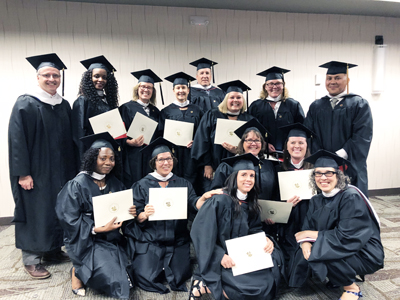
George Diaz M’10 (top right) poses with the members of the M.A. in Organizational Leadership program at a recent graduation.
“I can still picture George in my class,” Hines said. “He was a good student who was curious and always engaged in the classroom learning. This, along with his easy-going attitude and unflappable nature, really stood out to me and his classmates.”
Initially, he took the course simply because it fit his schedule before earning an M.A. in Human Development. Yet, a side conversation about his post-graduation plans with Hines would help compel him to start the Ed.D. program the next semester.
“She said, ‘Why don’t you work in education if you like it so much?’ And that’s where it really started,” Diaz said. “The aha! moment came about.”
Diaz always tells his students to ask as many questions as they can during their educational journey, given the insight those answers can possess to questioning minds — just like his own.
“If you don’t know the reasoning behind it, then you’re never going to remember it and it’s not worth your time learning it,” Diaz said. “Yes, some things will resonate with you; others won’t. But always understand why something does or does not.”
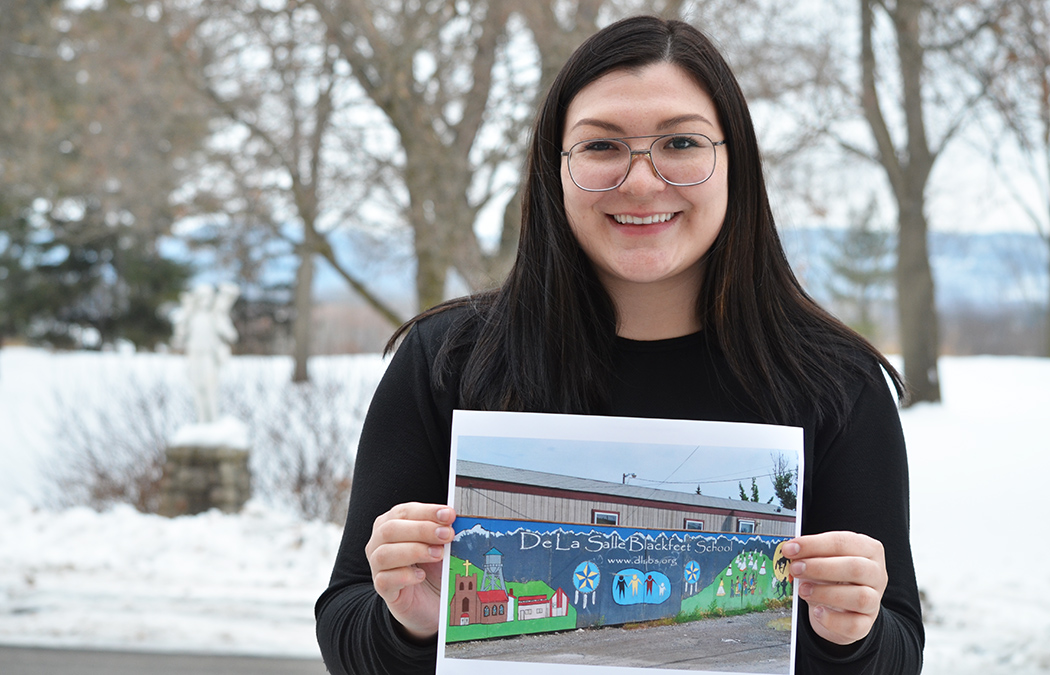
Student’s fundraising efforts turn tragedy to triumph
For Saint Mary’s University student Aimee Boggs ’20, hearing that her hometown school was in need of help was heartbreaking. Largely because of her ongoing fundraising efforts for the school, a tragic turn of events has turned into an uplifting story of generosity.
On Jan. 5, a trailer used for offices and storage at the De La Salle Blackfeet School in Browning, Mont., was vandalized and set on fire. This act of violence was especially tough for the Lasallian school, which Boggs said depends largely on volunteers and philanthropic gifts.
“I was upset because the school has been such a blessing to the Blackfeet community,” Boggs said. “Everybody from my siblings to my nephews have gone to this school, so to hear that someone would cause that type of damage to a school that not only runs on donations, but has been a light to our community, is devastating.”
Within just one day, Boggs, a 2012 graduate of De La Salle Blackfeet School, started a Facebook Fundraiser, with the hope of raising $20,000, to help the school purchase another trailer and replace its contents.
In less than a month, she has raised over $9,330. Additionally, she helped promote an ice-skating fundraiser for De La Salle, sponsored by the Office of Campus Ministry, and a hockey jersey raffle, made possible by the Athletics Department, both held Jan. 26 on the Winona Campus. Also that day, a collection was taken at Mass. About 75 people attended the ice-skating event, and these combined efforts raised just over $507.
“It’s great to see how quickly we have raised the money, and it’s cool to see how many people have shared the post,” Boggs said. “It just shows how supportive the Lasallian community is and how tight knit we actually are. To see the outpouring of love and support for our community has been heartwarming.”
Boggs hopes to keep her fundraiser going until her goal is met. Donations to the De La Salle Blackfeet School can also be sent directly to P.O. Box 1489, Browning, MT, 59417
This spring student volunteers with S.O.U.L. (Serving Others United in Love) will be completing a service trip to the school as well. Boggs serves as president of S.O.U.L., and her best friend and roommate will be leading this trip.
Boggs said the school serves about 75 students in grades four through eight. But she describes it as more than a school: “It is kind of like Saint Mary’s in the sense that we had so much individualized attention from our teachers,” she said. “And the Brothers made that school what it is. I felt safe and supported, and I looked forward to going every single day. I don’t think I ever missed school. Without De La Salle I wouldn’t be at Saint Mary’s. I probably wouldn’t be in college. It was literally my second home.”

Saint Mary’s furthers collaboration with Mayo Clinic Health System through athletics partnership
WINONA, Minn. — Saint Mary’s University of Minnesota and Mayo Clinic Health System – Franciscan Healthcare have entered into a joint venture focused on athletics.
“At Saint Mary’s, the health and well-being of our student-athletes is always our top priority,” said Brian Sisson, athletic director for Saint Mary’s University. “We are thrilled to be joining forces with Mayo Clinic Health System — a trusted leader in healthcare worldwide — which will create an unmatched experience for each and every one of our student-athletes.”
Through this partnership, Mayo Clinic Health System will provide Cardinal student-athletes additional sports medicine and athletic training care, as well as access to comprehensive health care services and professionals. The addition of a Mayo Clinic team doctor and a fourth athletic trainer to the department will assist in day-to-day services throughout the academic year and will further enhance the overall well-being, health, and safety of all Cardinal student-athletes.
“The entire team we have worked with to make this a reality has been truly amazing,” added Sisson. “We are grateful to have Mayo Clinic Health System as part of the Cardinal athletics team moving forward and know that this collaboration will set us apart among current and future student-athletes at Saint Mary’s.”
“The health and safety of athletes, including student-athletes, is very important to Mayo Clinic Health System and the Winona area community,” said Paul Mueller, M.D., regional vice president, Southwest Wisconsin Region, Mayo Clinic Health System. “Given our success with other similar regional partnerships, such as at the University of Wisconsin-La Crosse, we are confident we will replicate this level of service and expertise here in Winona at Saint Mary’s University.”
Alecia Gende, D.O., a member of the Mayo Clinic Health System sports medicine team, has been named medical director of Saint Mary’s athletics. Dr. Gende will offer consistent guidance to the university training room facilities with Mayo Clinic Health System athletic training staff.
“We are all excited about this new partnership and the many tangible benefits for both institutions,” said Dr. Gende. “We look forward to providing high-quality care to these amazing student-athletes that supports their overall performance.”
This joint venture furthers Saint Mary’s collaborative relationship with Mayo Clinic, which includes the 3+2 Physician Assistant Program launched in 2019. In that program, students spend three years taking classes at the new Science and Learning Center on the Winona Campus. The following two years, program participants learn from Mayo Clinic School of Health Sciences faculty at Saint Mary’s University’s Rochester Campus and have clinical learning experiences at Mayo Clinic in Rochester and throughout Mayo Clinic Health System.
“This is truly going to be a model learning environment for students to transition from the foundational sciences into a clinical care setting,” said Todd Reinhart, Sc.D., dean of the School of Sciences and Health Professions at Saint Mary’s University.
As part of the collaboration, Mayo Clinic Health System will be featured on scoreboard signage at numerous Cardinal athletic facilities, an event sponsor for the Cardinal Excellence Fund Dinner and golf outing annual fundraising events, and presenting sponsor of saintmaryssports.com, the official athletics website for the Saint Mary’s Cardinals.
Mayo Clinic Health System consists of clinics, hospitals and other facilities that serve the health care needs of people in Iowa, Minnesota, and Wisconsin. The community-based providers, paired with the resources and expertise of Mayo Clinic, enable patients in the region to receive highest-quality physical and virtual health care close to home.
With Brexit looming, more is unknown than known with British economy, trade agreements
Although it has been in the works since June 2016, the transition phase of Great Britain’s decision to leave the European Union (EU) — more commonly known as “Brexit” — is set to take place on Jan. 31. It is a date that will most likely leave a ripple of economic uncertainty in the United Kingdom in its wake as the British prepare for total independence at the end of the year.
“Brexit has created so many new unknown variables. It can be profoundly disruptive to England as we know it today,” says Ralf “Don” Keysser, D.B.A., an associate professor in the MBA program at Saint Mary’s University of Minnesota.
Keysser predicts a negative short-term impact to the British economy, whereas the long-term perspective is still hard to predict until new free trade agreements with Europe and the rest of the world are established.
Keysser does not see a clear-cut benefit to the U.S. establishing a free trade agreement with the U.K., simply based on the lack of British imports in the American market, other than maintaining political closeness.
“It’s going to be a shock to the system. England will not be the England that it has been. There’s a lot of speculation, because we’ve never had a country pull out of the EU before, so it’s kind of an unknown. And it’s so highly politicized that it’s hard to get an objective analysis of what it’s going to look like.”
Keysser points to a Toyota plant in South Derbyshire that supplies most of its output to countries in the EU through a tariff-free treatment. With Brexit going into effect, the factory may have to vastly reduce its output. Still, the workers in that community overwhelmingly voted to leave the EU.
“This is a good example of how people will vote against their economic self-interests for ideological reasons,” Keysser says. “There’s a lot of ideology behind the Brexit vote: anti-immigrant, anti-Europe, pro-nationalist views that very much echoed President Trump’s appeal.”
There are a few reasonably good projections, Keysser says, to make about the impact on inflation, unemployment, and economic trends — and none of them look good for Britain. One just has to look at the British pound, which has steadily been losing value to the dollar and euro over the years. In addition, several banks decided to either move from London or expand into other markets within the EU as soon as the Brexit results were announced, which could cost the British capital its status as one of the world’s premier financial centers.
“I see a gradual diminution of the financial business that’s been a mainstay of London,” Keysser says.
On top of that, there is a real fear of Scotland and Northern Ireland wanting to leave the U.K. in favor of establishing their own independence and returning to the EU. The last time Scotland voted to leave the U.K. in 2004 it only passed 55% to 45%.
“That could be the beginning of the end of the United Kingdom as we have known it,” Keysser says.
The news might not be entirely bad out of Brexit. For international tourists, especially those from the U.S., looking to take advantage of the dollar’s exchange rate with the declining pound.
Do you want to know more about the possible economic ramifications of Brexit? Are you a journalist covering this topic and interested in an interview? That’s where we can help.
Ralf Keysser, D.B.A., has been an active investment banker and business finance consultant for 35 years. He also serves an associate professor for the MBA program at Saint Mary’s University of Minnesota. To book an interview with him, simply click on his photo below to access his contact information.
Connect with:
Ralf “Don” Keysser, D.B.A.
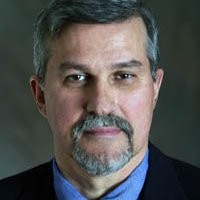 Adjunct Associate Professor, M.B.A. Program
Adjunct Associate Professor, M.B.A. Program
Expertise: Business and finance
View profile

Going green: National mental health awareness movement reaches Winona Campus
Student-driven cause is part of larger campus initiative that launched in 2019
This semester, the Winona Campus at Saint Mary’s University of Minnesota may look a little greener than usual.
That’s because 55 student-athletes will have specialized lime green bandanas on their backpacks as part of what has become a national movement called the Green Bandana Project.
Anyone with the bandana indicates to passersby that they are a safe individual to approach with mental health-related issues and can provide cards containing additional resources, such as those listed on this PDF, located inside their accompanying mental health resource tags.
“It’s a sign that someone is always there for you,” said Justine Schultz, a junior from Winona who has helped spearhead the movement at Saint Mary’s, of the bandanas and tags. “You might not think someone will be open to talk to you, but someone will always be there to listen.”
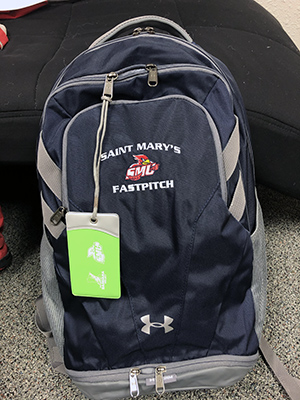
Those who receive the certified training will receive a lime green mental health resource tag along with a matching bandana that will be tied to their backpacks.
What began in 2016 at the University of Wisconsin-Madison with a first-year student handing bandanas to fellow students has blossomed into a large initiative to raise awareness of mental health on college campuses. Participating campuses include the University of Minnesota; Minnesota State University, Mankato; St. Olaf University; and Winona State University.
When Karen Hemker M’04, director of Access Services in the Student Success Center, heard that a group of student-athletes from Winona State had started a chapter on their campus, she decided the initiative would be a perfect way to help reinforce an ongoing commitment to mental health awareness made in the university’s strategic plan that began with the formation of the Mental Health Task Force in spring 2019.
As fate would have it, Schultz is a student worker in Hemker’s office. Given that Schultz is not only a psychology major but also a catcher on the softball team, Hemker asked if she would be interested in drumming up support from fellow student-athletes on campus, as Hemker was aware of Schultz’s passion for supporting students with mental health issues on campus. Schultz quickly got on board, as did Samantha Borawski ’15, M’17, an assistant coach on the softball team who also serves as an advisor to the Student-Athlete Advisory Committee (SAAC).
The green mental health resource tags feature both the Green Bandana Project logo as well as the university’s logo.
“We said, ‘If we are starting this chapter at Saint Mary’s, we want students to be proud to be a part of the project.’ We thought that personalizing the resource items would be a nice little touch for those who do choose to complete the training,” Borawski said of the specialized tags and bandanas.
In her research, Hemker noticed that different chapters required different amounts of involvement. On some campuses, students only had to take an oath to get the green bandana or tag.

The digital depiction of what the new green bananas will look like, featuring both the Saint Mary’s logo and the Green Bandana Project logo.
“We wanted to participate, but we also wanted to support our students by giving them additional training in mental health, rather than just have them sign a pledge,” Hemker said. “It was important to us to have a more structured program so students were using the correct language and had some training.”
To receive a tag, students have to complete a two-hour training session. The first was conducted on Jan. 12 with 55 student-athletes led by Connie Mettille, a professor at Winona State, who is heavily involved in making students, faculty, and staff at Winona State aware of mental health issues. — Karen Hemker
Mettille also led the training sessions of an eight-hour Mental Health First Aid class based on material from the National Council for Behavioral Health that was initially offered to faculty and staff at Saint Mary’s and later to resident assistants and other student leaders. Hemker, Borawski, and Schultz had all undergone this training in the spring.
“We wanted to participate, but we also wanted to support our students by giving them additional training in mental health, rather than just have them sign a pledge.”
–Karen Hemker
The trio was pleased with the level of engagement the student-athletes displayed for the inaugural training session; several teams have expressed interest in going through the eight-hour training together. They hope to offer more training sessions later this spring, as the overall goal is to train anyone who is interested in serving as a resource to support mental health issues within the university community, Hemker said.
Borawski and Hemker expressed their gratitude to the administration for supporting this initiative. Faculty and staff members who have been through the Mental Health First Aid training will also be provided green bandanas to make students aware of the support among the faculty and staff as well.
Featured image: The inaugural training for the Saint Mary’s chapter of the Green Bandana Project on the Winona Campus took place on Jan. 12. Fifty-five student-athletes took part. Those in charge hope to have another training session for all students later in the spring.

Finding a match: Former Cardinal tennis star takes passion for game to the working world
Laura Sonday ’19 did not plan on falling in love with Saint Mary’s University of Minnesota. After having two older sisters (Mara ’10, C’17, M’18 and Anna ’13) and her mother, Mooreen M’04, attend the university, she liked the idea of blazing her own trail at a different school after graduating as a tennis standout from South St. Paul High School in 2015. But fate had other ideas.
“I tried to tell myself I wasn’t going to come to Saint Mary’s because my sisters both did, but then I went on campus and met with Coach [Jeff] Halberg and the girls who were on the team at the time,” recalls Sonday, who is a native of West St. Paul. “I just felt like they cared what my opinion was. They cared about me and what I wanted to talk about.”

During her four years as a member of the Saint Mary’s women’s tennis team, Laura Sonday ’19 played No. 1 singles and doubles, compiling a combined record of 112-65. This spring, she will return to the team as a volunteer assistant coach.
Sonday, who double majored in marketing and Spanish, was impressed with how Halberg personally set up a meeting with Christian Michener, Ph.D., the director of the Lasallian Honors Program, and walked with her to the meeting when she was on her campus visit.
Sonday finished her career at Saint Mary’s playing No. 1 singles and doubles for all four years with a combined record of 112-65 and five All-Minnesota Intercollegiate Athletic Conference (MIAC) First-Team honors. Her academic accomplishments were just as impressive as a four-time ITA Scholar-Athlete and three-time All-MIAC Academic selection. Last season, she was selected for the MIAC Chris Evert Award, given annually to a “senior tennis student-athlete who exhibits outstanding sportsmanship and exemplary athletic, academic, and humanitarian accomplishments,” according to the MIAC.
“She left such a lasting impact because she’s just such a generous and selfless person who gave so much of herself to the team and to the school,” Halberg says.
Now, after four years in Winona, Sonday finds herself back in the Twin Cities and part of a new team that still allows her passion for tennis to burn bright. Since July, Sonday has been working as a media and marketing coordinator for Bleachr, a mobile sports app startup company based in downtown Minneapolis.
Bleachr began in 2015 with the Saint Paul Saints minor league baseball team as its first client, developing a fan experience app to allow fans to enter contests, order tickets for future games, and access other amenities. The company has since expanded into three branches: BaseballONE (minor league baseball teams), CollegeONE (major college athletics), and Sonday’s favorite, TennisONE (professional tennis tournaments).
‘A kid in a candy store’
As part of the marketing team, Sonday started her new job by going to four professional tennis tournaments across the country, beginning with the Hall of Fame Open in Newport, R.I., the only grass-surface tournament of its kind in the U.S.
“I was like a kid in a candy store,” Sonday said. “It was amazing. There’s just so much tennis history there. It’s such a small, intimate tournament where players are just walking around.”
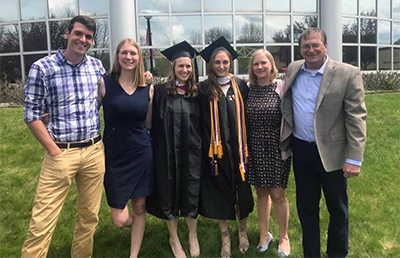
The Sondays are no strangers to Saint Mary’s, having six degrees from the university between the seven of them (from left): Sam (Olsem) ’13, Anna ’13 (Sam’s spouse), Mara ’10, C’17, M’18; Laura ’19, Mooreen M’04 and Dave at the spring 2019 commencement.
Bleachr had built an app specifically for each tournament. While on assignment, Sonday and her fellow team members help patrons download that event’s app and answer any questions they may have.
“And then I get to watch pro tennis when it’s not busy, which is amazing,” added Sonday, who grew up cheering for tennis icons Roger Federer and Serena Williams. “And I get to write about all of my experiences.”
Currently, Bleachr creates apps for tournaments in four different countries: U.S., Canada, France, and Switzerland. Sonday hopes the operations might expand to Spanish-speaking countries in the future, allowing her to keep her Spanish skills fresh.
It should be noted that as part of her thesis, she translated some of the university’s admission materials into Spanish. Said Sonday: “We have such a strong First Generation Initiative program with people who are bilingual. Everyone deserves to have materials in a language they and their families are comfortable in.”
When Sonday first thought of a possible career, she envisioned herself running tournaments such as the ones where she has worked. Her perspective, though, has changed.
“Now that I’ve been there and seen how much work there is, maybe not. But just being able to go and still be a part of that is definitely as close to a dream job as I think you can get,” Sonday said.
“She left such a lasting impact because she’s just such a generous and selfless person who gave so much of herself to the team and to the school.”
—Jeff Halberg, women’s tennis coach
Sonday is especially excited about the launch of Bleachr’s TennisONE app, the first proprietary venture for the company. It features a wide array of platforms for fans of the game, including news, live scores, draws, and interactive gaming.
She finds daily inspiration from Bleachr’s co-founder and CEO Kristin Geer, who reached out to Sonday through LinkedIn.
“She motivates me to make a path for myself as a professional woman,” Sonday said of Geer.
Last September, Sonday attended a “Women in Tech” event sponsored by Minne Inno when she heard something that has stuck with her: Oftentimes, in a room, men find it very easy to go up to people to network. Women don’t always find it so easy because they don’t like to interrupt. If you can go into those networking situations with a friend, though, it can be less intimidating.
“I’ve never heard somebody give that advice before,” Sonday said. “They always want you to be strong and independent, but you can do that with support.”
A new season
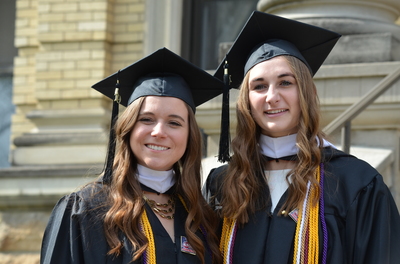
Laura Sonday ’19 takes a photo with Julia Boeve ’19 (St. James, Minn.), fellow senior on the women’s tennis team, during the spring 2019 commencement on the Winona Campus.
Although Sonday’s time as a player with the Cardinals has ended, Saint Mary’s fans will be able to see her at the Winona Tennis Center in a different capacity, as she will be serving as a volunteer assistant coach for Halberg. The season begins Jan. 24, with a match against Martin Luther College at the center.
“I always tell my players that the measure of success is not how much you make but whether you enjoy what you do and find real value in it,” Halberg said. “Laura does, and I’m so pleased for her because that’s really the holy grail.”
Sonday says that she will continue to balance the weekend drives to Winona in the spring with her job in Minneapolis for as long as Halberg will have her on staff. It’s a commitment she is willing to make given her passion for both pursuits.
“I’m not looking for a place that’s a stepping stone,” Sonday says of her job at Bleachr. “I’m looking for a place that I can grow with and that I can help grow. And this seems like a place for that. The good news about a startup is that you often get to help shape your own role.
“I see myself here in the Twin Cities for a long time, still at Bleachr with hopefully some Grand Slam [major tournaments] under our belt.”
Featured image: Laura Sonday ’19 has been working in the marketing department for Bleachr, a company that develops fan experience apps for professional sports teams, college athletic programs, and tournaments.

